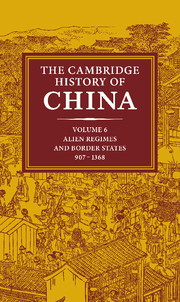Book contents
- Frontmatter
- Introduction
- 1 The Liao
- 2 The Hsi Hsia
- 3 The Chin dynasty
- 4 The rise of the Mongolian empire and Mongolian rule in north China
- 5 The reign of Khubilai khan
- 6 Mid-Yüan politics
- 7 Shun-ti and the end of Yüan rule in China
- 8 The Yüan government and society
- 9 Chinese society under Mongol rule, 1215–1368
- Bibliographical essays
- Bibliography
- Glossary-Index
- MAP 7. The Liao empire, ca. 1045
- MAP 12. The Hsi Hsia state, IIII
- Map 17. The Chin empire
- MAP 32. The Yüan empire">
- References
1 - The Liao
Published online by Cambridge University Press: 28 March 2008
- Frontmatter
- Introduction
- 1 The Liao
- 2 The Hsi Hsia
- 3 The Chin dynasty
- 4 The rise of the Mongolian empire and Mongolian rule in north China
- 5 The reign of Khubilai khan
- 6 Mid-Yüan politics
- 7 Shun-ti and the end of Yüan rule in China
- 8 The Yüan government and society
- 9 Chinese society under Mongol rule, 1215–1368
- Bibliographical essays
- Bibliography
- Glossary-Index
- MAP 7. The Liao empire, ca. 1045
- MAP 12. The Hsi Hsia state, IIII
- Map 17. The Chin empire
- MAP 32. The Yüan empire">
- References
Summary
INTRODUCTION
The founding of the Liao dynasty at the beginning of the tenth century opened a second period of extensive foreign dominance in China, a period that would last for almost half a millennium and that reached its climax with the conquest by the Mongols of all of China in 1279. Never before had China suffered such a degree of political and military domination by foreign peoples for such a protracted period. The Khitan Liao, the Tangut Hsi Hsia, the Jurchen Chin, and the Mongol Yüan in turn exercised an ever-increasing control over Chinese territory. The surviving Chinese regimes were forced to acknowledge these conquest dynasties on Chinese soil as equal if not superior powers, to establish permanent diplomatic relations with them on an equal footing, and to pay them annual subsidies or tribute. Such a state of affairs was totally at variance with the traditional Chinese worldview, which saw China as the center of the civilized world around which other peoples and nations had to orbit, and to which they were expected to display submission and deference.
Nothing better illustrates the new power of the north Asian tribal peoples than the fact that throughout Eurasia the name of the Khitan, the founders of the Liao dynasty, in such forms as Kitaia, Cathaia, or Cathay, became a synonym for China. In Russia and throughout the Slavonic world it still remains the standard designation for China.
Keywords
- Type
- Chapter
- Information
- The Cambridge History of China , pp. 43 - 153Publisher: Cambridge University PressPrint publication year: 1994
References
- 12
- Cited by



